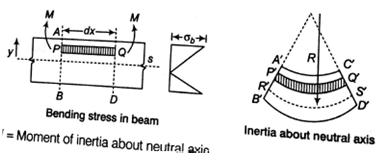Bending Moments and Shear Stress Distribution
Bending stress and shear stress distribution are classified in the following groups
Bending Moment in Beam:
Transverse loads or lateral loads: Forces or moments having their vectors perpendicular to the axis of the bar.
Classification of structural members.Axially loaded bars :- Supports forces having their vectors directed along the axis of the bar.Bar in tension:- Supports torques having their moment vectors directed along the axis.Beams :- Subjected to lateral loads.Beams undergo bending (flexure) because of lateral loads.
When beam is subjected to a bending moment or bent there are induced longitudinal or bending stress in cross-section.

Note that a positive bending moment M causes negative (compressive) stressabove the neutral axisand positive ( tensile) stress below the neutral axis
Equation of Pure Bending:

Assumptions:
The material of the beam is homogeneous and isotropic.The value of Young's Modulus of Elasticity is same in tension and compression.The transverse sections which were plane before bending, remain plane after bending also.The beam is initially straight and all longitudinal filaments bend into circular arcs with a common centre of curvature.The radius of curvature is large as compared to the dimensions of the cross-section.Each layer of the beam is free to expand or contract, independently of the layer, above or below it.
Strength of Materials
At the neutral axis, there is no stress of any kind. At one side of the neutral axis, there are compressive stresses.
Modulus of Section:
Elastic section modulus is defined as Z(S) = I / y, where I is the second moment of area (or Izz moment of inertia) and y is the distance from the neutral axis to any given fibre.
Section modulus is a geometric property for a given cross-section used in the design of beams or flexural members.
Rectangular section :
Modulus of section :
Circular section :
Modulus of section :
Beams of uniform strength:
The beam is said to be in uniform strength if the maximum bending stress is constant across the varying section along its length.Generally, beams are having the uniform cross-section throughout their length. When a beam is loaded, there is a variation in bending moment from section to section along the length. The stress in extreme outer fibre (top and bottom) also varies from section to section along their length. The extreme fibers can be loaded to the maximum capacity of permissible stress (say pmax), but they are loaded to less capacity. Hence, in beams of uniform cross section there is a considerable waste of materialsWhen a beam is suitably designed such that the extreme fibers are loaded to the maximum permissible stress pmax by varying the cross section it will be known as a beam of uniform strength.
Shearing Stress
Shearing stress on a layer JK of beam at distance y from neutral axis.

Where,
V = Shearing force
First moment of area
Shear stress in Rectangular Beam
Suppose, we have to determine the shear stress at the longitudinal layer having y distance from neutral axis.

Circular Beam
Centre of gravity of semi-circle lies at distance from centre or base line. As it is symmetrical above neutral axis, hence at neutral axis shear stress will be maximum.

Shears Stress in Hollow Circular Cross-Section
In hollow circular cross-section, if we have to calculate τ at neutral axis by the formula
Shear Stress in Triangular Section
In a triangular cross-section, if we have to calculate τ at neutral axis, then in formula
Shear Stress in I-section

